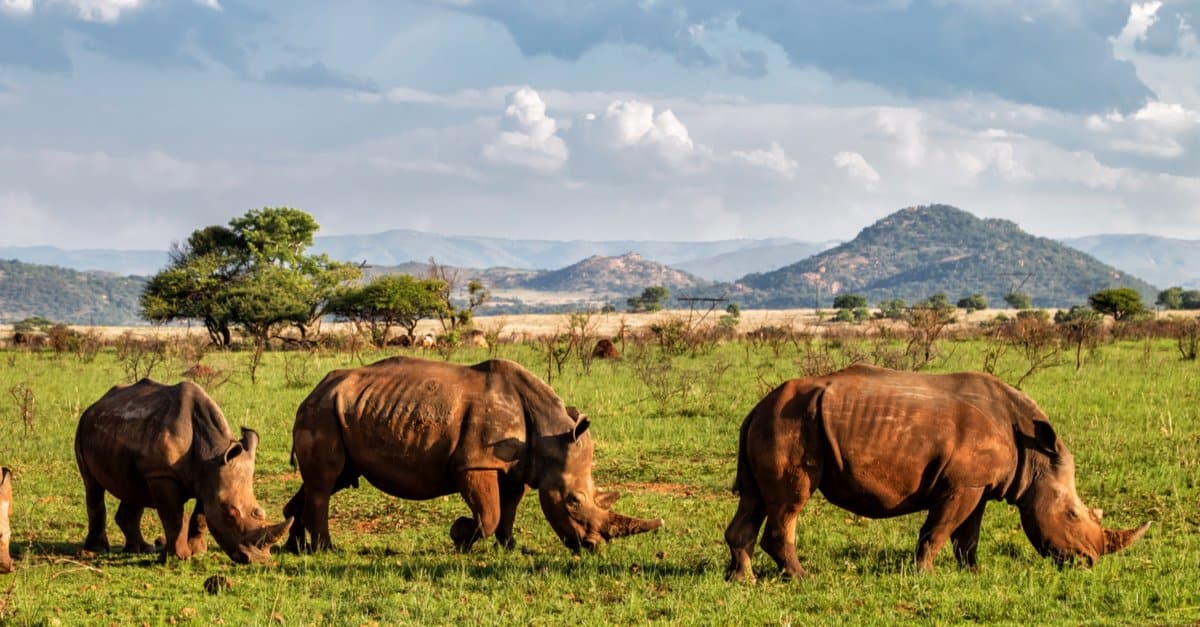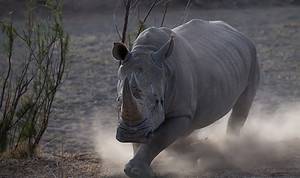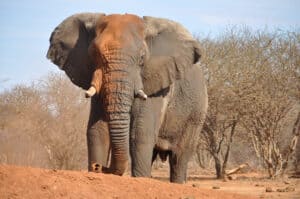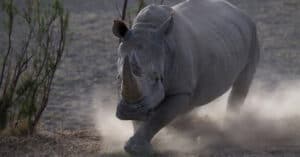A rhino is a large, herbivorous mammal belonging to the family Rhinocerotidae. They are characterized by their thick skin, two horns on their snouts, and three-toed hooves. There are five species of rhinos: White Rhino, Black Rhino, Indian Rhinoceros (or Greater One Horned Rhino), Javan Rhino, and Sumatran Rhinos. All five species of rhinos live in Africa and Asia except for the white rhino, which lives in southern Africa. The population of all five species is rapidly decreasing. This is due to poaching for their horns and habitat loss due to human development. Conservation efforts have been increasing recently, but more needs to be done! All the help is needed if these majestic creatures are going to survive beyond our lifetimes!
A Group of Rhinos

When threatened by predators like lions or hyenas, rhinos come together to protect their young and fend off danger.
©Jurgens Potgieter/Shutterstock.com
A group of rhinos is called a crash. In a normal-sized crash, there will usually be one dominant rhino who will defend his territory from intruders. The females within the group are often related to each other. They usually stay together while the males go off alone or in pairs during certain times of the year. White Rhinos are a bit more social than other types. This means that they often interact by rubbing heads, playing games, wallowing in mud holes, and participating in various activities. When threatened by predators like lions or hyenas, rhinos come together to protect their young and fend off danger. This shows just how strong these animals’ bond is with one another!
Group of Rhinos Size
The white rhino is one of the two species of African rhinos and has large complex social structures. Group sizes can vary greatly. From small family units with a single adult female and her calves to larger groups of up to fourteen individuals. These herds will typically consist mostly of females and their offspring. Occasionally, they will include an unrelated individual or two. In addition to these larger groupings, white rhinos tend to form smaller subgroups within them. These groupings will be based on age, gender, or other factors. The black rhino is generally more solitary and rarely forms any kind of social grouping beyond a mother-calf pair.
The other types of rhinos are generally considered to be solitary animals. They typically spend most of their time alone. They may interact with other rhinos during mating season or when a female has a calf. However, there have been recent observations of groups of rhinos spending time together in the Okavango Delta in Botswana.
Group of Rhinos Behavior
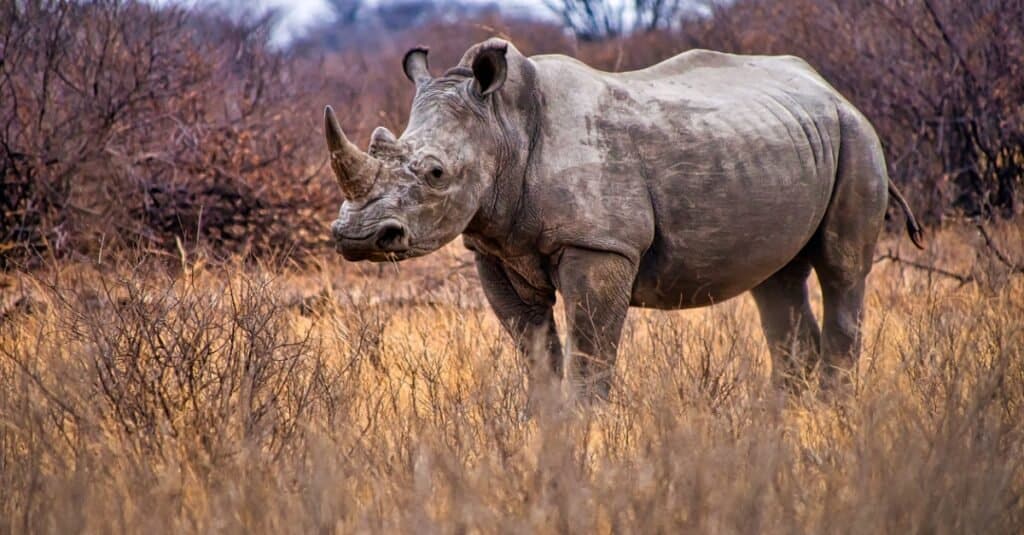
Rhinos and
elephants
tend to often fight over territory.
©iStock.com/Alberto Carrera
Group behavior in rhinos is highly dependent on the specific species. African black rhinos, for example, are solitary animals and do not typically form groups. However, white rhinos can be found in small herds. These family units consist of a female and their offspring, remaining until they reach maturity or disperse from the group. They will defend their territory fiercely against intruders while protecting young or weak members of the herd. Despite this territoriality within a given herd, there is usually minimal aggression between members. Aggression may rise if resources become scarce or if an interloper attempts to join the existing structure.
Group of Rhinos: Communication
Rhinos communicate with each other mainly through sounds such as snorts, bellows, and grunts. They also use smells to mark their territories and let others know where they are located. Rhinos will use body language to express themselves, such as posturing when threatened or aggressive behavior. Additionally, rhinos have a unique form of communication known as “mud-bathing.” This involves wallowing in mud pits together while exchanging rumbles and squeaks, which likely serves the purpose of bonding between members of the same group.
Grazing and Eating

Depending on where they live, some rhino species may eat aquatic plants like reeds or waterlilies near rivers or wetlands.
©Jurgens Potgieter/Shutterstock.com
Rhinos are herbivores and primarily feed on grasses, leaves, twigs, fruit, and bark. They generally graze in the early morning and late afternoon, with a break in between for rest or wallowing. Rhinos also supplement their diet with mineral-rich soil or salt licks to provide them with necessary minerals. Additionally, rhinoceroses have been known to eat branches and shrubs and the highest leaves on the trees they can reach. Depending on where they live, some rhino species may eat aquatic plants like reeds or waterlilies near rivers or wetlands. Others living in drier areas will eat cacti or succulents instead of grasses.
Group of Rhinos: Courting and Mating
Female rhinos reach the age of sexual maturity at three years old, while males don’tdon’t become ready to breed until they are around seven. The mating process follows the same pattern as with other large mammals, with the male mounting the female from behind in an attempt to penetrate her. However, the courtship process before mating is usually intense and dangerous. Females will ovulate every 28 days and are receptive to males for one or two days. However, they will only do this if they are away from their mothers, as they will not ovulate if their mother is nearby.
Courting Process
Males will use dung to mark their area and let other males know of their presence and any potential female partners. When a female is ready, males will glimpse her scent and engage in clashes to be the chosen one. These battles can be intense and often end in injuries. Once the male has been accepted, the female will pursue him.
When a female rhino has found the particular male that strikes her fancy, she will begin the courtship process. She will make a whistling noise, which may appear to be like bubbles if she is underwater. In addition, she will follow the male around, leaving a scent trail to let other females know that she has already claimed him.
When a pair of rhinos are interested in each other, the female will follow the male and engage in what is known as a “bluff and bluster” ritual, which can last for hours. This activity can become quite vigorous, with the male thrashing his head and the two creatures sometimes fighting and biting each other before mating. This process can be dangerous and even deadly, as seen at Dhaka Zoo in Bangladesh when a male rhino was thought to have been killed during an overly aggressive courtship ritual.
Group Parenting
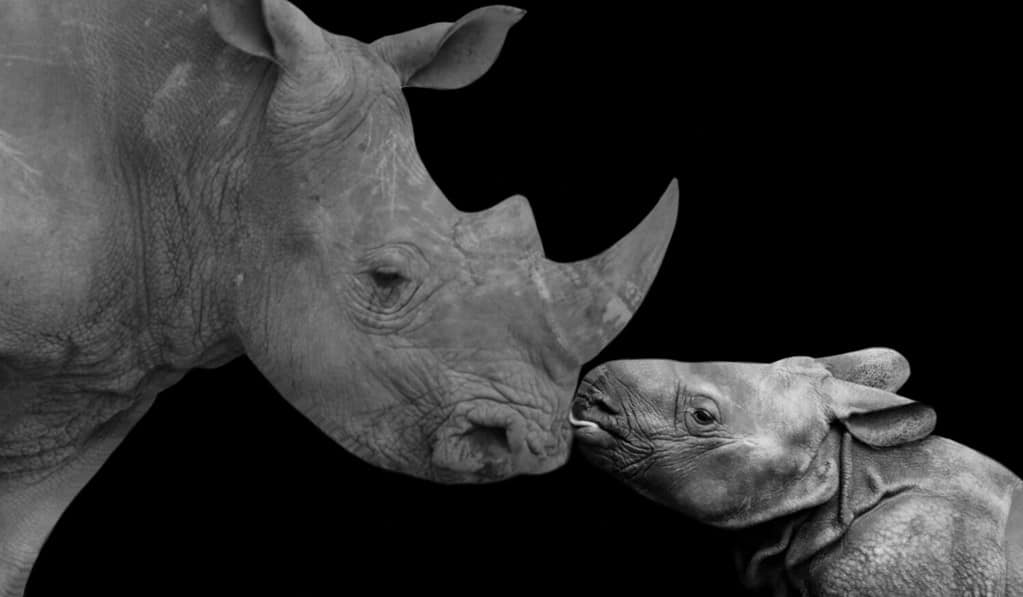
A female
rhinoceros
will typically pick a secluded area to give birth.
©R.S.H Photoshoots/Shutterstock.com
Many animals have a single parent who cares for the young, but the rhinoceros is an exception. Breeding typically occurs between February and August, with the calf being born during the wet season (when food is abundant) from October to April. As the due date approaches, the mother rhino becomes extremely protective and aggressive toward any creature that may come close to her. This may be because she is cranky after a long 16-month pregnancy!
A female rhinoceros will typically pick a secluded area to give birth. When the calf is born, it can weigh between 50 and 110 pounds. An adult rhino can remain underwater for five minutes, but the mother only has 40 seconds to bring her baby to the surface for its first breath. After the calf’scalf’s birth, the mother will stay with it for a few weeks, nursing and forming a bond with it before returning to the herd.
Parenting Features
About two weeks after giving birth, the mother rhino rejoins her herd with her calf. She will nurse the baby for at least eight months, even when submerged underwater, due to the infant’sinfant’s ability to close its nostrils and fold its ears. As the female mates once every two years, she has plenty of time to devote to her calf. This forms a strong bond between mother and child, which is seen through nuzzling, licking, cuddling, and mutual grooming. The male also plays an important role in caring for the calf, acting as a fierce protector against potential predators such as lions, hyenas, and crocodiles. He stands guard on their territory’s banks while the female protects from within the pool.
A group of rhinos (called a clash) will raise the calf for several years with up to four siblings. Upon reaching sexual maturity at 42 months, a young male will break away from his mother and compete with others to gain dominance. Female rhinos may stay with their mothers for much longer.
Thank you for reading! Have some feedback for us? Contact the AZ Animals editorial team.

